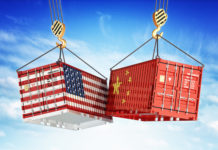
PHASE ONE TRADE AGREEMENT IMPLEMENTATION BEGINS ON 2/14/20
UPDATE
Last week, on January 15, President Trump signed a Phase One trade deal with China. The Section 301 additional tariff on List 4A goods imported from China will be reduced from 15 percent to 7.5 percent on Valentine’s Day, Feb. 14, according to the Office of the U.S. Trade Representative. February 14 will be the effective date of the phase one trade agreement the U.S. and China that was just signed.
A full list of goods affected by this change, which have a total trade value of approximately $120 billion, is available here.
In addition to this reduction in tariffs, importers of List 4A goods, which have been subject to higher tariffs since Sept. 1, 2019, can request exclusions for their goods. However, such requests must be filed by Jan. 31. Requests must be submitted through an online portal. The MBS Trade Team is already processing such filings for firm clients now.
The deal will cut the 15 percent tariffs on $120 billion of Chinese imports in half, but leave 25 percent tariffs on an additional $250 billion of imports in place. The agreement prevented a planned tariff rate hike in October 2019 and a new round of tariffs in December 2019.
It is important to note: President Trump has specifically stated that the tariffs on $360 billion in products will remain in place as an enforcement mechanism. Though negotiations are expected to begin immediately, a ‘Phase Two’ agreement is not anticipated until after the U.S. elections, specifically no sooner than 10 months after today’s signing. Success of the negotiations will hinge on China’s adherence to the Phase One Agreement.
– – –
MORE ON THE AGREEMENT
- Intellectual Property: The Intellectual Property (IP) chapter addresses numerous longstanding concerns in the areas of trade secrets, pharmaceutical-related intellectual property, geographical indications, trademarks, and enforcement against pirated and counterfeit goods.
- Technology Transfer: The Technology Transfer chapter sets out binding and enforceable obligations to address several of the unfair technology transfer practices of China that were identified in USTR’s Section 301 investigation. For the first time in any trade agreement, China has agreed to end its long-standing practice of forcing or pressuring foreign companies to transfer their technology to Chinese companies as a condition for obtaining market access, administrative approvals, or receiving advantages from the government. China also commits to provide transparency, fairness, and due process in administrative proceedings and to have technology transfer and licensing take place on market terms. Separately, China further commits to refrain from directing or supporting outbound investments aimed at acquiring foreign technology pursuant to industrial plans that create distortion.
- Agriculture: The Agriculture chapter addresses structural barriers to trade and will support a dramatic expansion of U.S. food, agriculture and seafood product exports, increasing American farm and fishery income, generating more rural economic activity, and promoting job growth. A multitude of non-tariff barriers to U.S. agriculture and seafood products are addressed, including for meat, poultry, seafood, rice, dairy, infant formula, horticultural products, animal feed and feed additives, pet food, and products of agriculture biotechnology.
- Financial Services: The Financial Services chapter addresses a number of longstanding trade and investment barriers to U.S. providers of a wide range of financial services, including banking, insurance, securities, and credit rating services, among others. These barriers include foreign equity limitations and discriminatory regulatory requirements. Removal of these barriers should allow U.S. financial service providers to compete on a more level playing field and expand their services export offerings in the Chinese market.
- Currency: The chapter on Macroeconomic Policies and Exchange Rate Matters includes policy and transparency commitments related to currency issues. The chapter addresses unfair currency practices by requiring high-standard commitments to refrain from competitive devaluations and targeting of exchange rates, while promoting transparency and providing mechanisms for accountability and enforcement. This approach will help reinforce macroeconomic and exchange rate stability and help ensure that China cannot use currency practices to unfairly compete against U.S. exporters.
- Expanding Trade: The Expanding Trade chapter includes commitments from China to import various U.S. goods and services over the next two years in a total amount that exceeds China’s annual level of imports for those goods and services in 2017 by no less than $200 billion. China’s commitments cover a variety of U.S. manufactured goods, food, agricultural and seafood products, energy products, and services. China’s increased imports of U.S. goods and services are expected to continue on this same trajectory for several years after 2021 and should contribute significantly to the rebalancing of the U.S.-China trade relationship.
- Dispute Resolution: The Dispute Resolution chapter sets forth an arrangement to ensure the effective implementation of the agreement and to allow the parties to resolve disputes in a fair and expeditious manner. This arrangement creates regular bilateral consultations at both the principal level and the working level. It also establishes strong procedures for addressing disputes related to the agreement and allows each party to take proportionate responsive actions that it deems appropriate. The United States will vigilantly monitor China’s progress in eliminating its unfair trade practices and implementing these obligations.
– – –
Read the full text of the Phase One agreement here
Agriculture and Seafood Related Provisions (Short)
Agriculture and Seafood Related Provisions (Long)
- Agricultural Biotechnology
- Animal Feed
- Seafood
- Dairy and Infant Formula
- Horticultural Products
- Meat, Poultry, and Live Breeding Cattle
- Pet Food
- Rice
Macroeconomic Policies and Exchange Rate
Interested in the latest in Washington D.C. politics and government?Sign up today!





